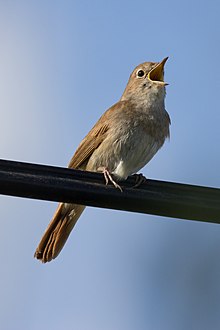Nightingale
| Common nightingale | |
|---|---|
 |
|
| Scientific classification | |
| Kingdom: | Animalia |
| Phylum: | Chordata |
| Class: | Aves |
| Order: | Passeriformes |
| Family: | Muscicapidae |
| Genus: | Luscinia |
| Species: | L. megarhynchos |
| Binomial name | |
|
Luscinia megarhynchos (Brehm, 1831) |
|
The common nightingale or simply nightingale (Luscinia megarhynchos), also known as rufous nightingale, is a small passerine bird best known for its powerful and beautiful song. It was formerly classed as a member of the thrush family Turdidae, but is now more generally considered to be an Old World flycatcher, Muscicapidae. It belongs to a group of more terrestrial species, often called chats.
"Nightingale" is derived from "night", and the Old English galan, "to sing". The genus name Luscinia is Latin for "nightingale" and megarhynchos is from Ancient Greek megas, "great" and rhunkhos "bill".
The common nightingale is slightly larger than the European robin, at 15–16.5 cm (5.9–6.5 in) length. It is plain brown above except for the reddish tail. It is buff to white below. Sexes are similar. The eastern subspecies L. m. hafizi and L. m. africana have paler upperparts and a stronger face-pattern, including a pale supercilium. The song of the nightingale has been described as one of the most beautiful sounds in nature, inspiring songs, fairy tales, opera, books, and a great deal of poetry.
It is a migratory insectivorous species breeding in forest and scrub in Europe and south-west Asia, and wintering in sub-Saharan Africa. It is not found naturally in the Americas. The distribution is more southerly than the very closely related thrush nightingale Luscinia luscinia. It nests on or near the ground in dense vegetation. Research in Germany found that favoured breeding habitat of nightingales was defined by a number of geographical factors.
...
Wikipedia

